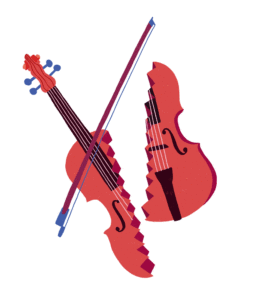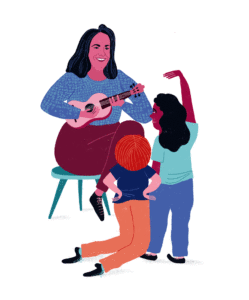Celina Velez ’07 is a K–5 music teacher in Philadelphia. Recently named to Yamaha’s 40 Under 40 list, she has been recognized for her classroom investment and effective pedagogy. A talented musician with over a decade of teaching experience, Celina has had time to learn a thing or two about music, kids, and how the two work together.
Pursue Progress, Not Perfection.
At age six, Celina was selected for the Gifted Young Musicians at Temple University Prep Program. She played Suzuki violin and received private lessons from a highly regarded performer. She was taught to strive for excellence, learning how to play a piece before even learning how to read the music.
Her high standards transferred to her students when she began teaching in a high school, and as Celina reflected, “I was really, really rough on them.” It was natural for her to know how the piece was supposed to sound, and when it didn’t measure up, to let her students know that what they were producing wasn’t good enough. But the longer she taught, the more her perspective on the goal of music changed:
“I don’t want to sound like I’m sacrificing excellence, but I think that in our pursuit for excellence, we risk turning people off completely from the arts. There is value in progress, and there is value in performing music for yourself and for others that might not be the most technical or beautiful. Plus, they’re still learning. That’s the whole point of learning music.”
Give a Global Perspective of Music and Musicians.
Music is uniquely positioned to connect people across borders, cultures, and languages. That’s why Celina, who is teaching in a predominantly hispanic community in North Philadelphia, makes it a priority to expose her students to all types of music from around the world. Her K–3 grade students get a “musical passport” and “visit” four countries a year to learn more about their music and culture. She exposes them to things they have never heard before, but that doesn’t mean that there aren’t new lessons in more familiar territories:
“I played a song for them to guess the genre and a student said, ‘That’s rock. That’s white people music.’ So I said, ‘Well, it is rock, so you’re correct about one of those things. But actually, this song is performed by an Afro-Cuban woman.’ I reminded them of a time (my time, not theirs) when people went to physical stores to buy physical CDs. The store didn’t label its inventory white music, black music, and brown music. They label it rock, jazz, EDM, electric, classical.”
Celina believes that this assumption of certain types of music for certain types of people should be dismissed as early as possible, especially at the elementary level when they will soon be given the opportunity to choose an instrument for themselves. Seeing all different types of people play all different types of instruments and genres shows her students all of the opportunities that are available to them.
“Some people think Hispanics just play trumpet and saxophone. Actually, this Hispanic plays the violin, and I often prefer German music from 300 years ago.”
Teach in a Way That Students Will Want to Learn.
Most public schools require music education through eighth grade. This creates an interesting reality in which every classroom will have students who aren’t all that excited about music. To help her students cultivate a love of music (and not just a specific type of music), Celina will offer a choice to her students whenever possible. When learning the recorder, the expectation is to learn how to play “Hot Cross Buns” or the like from the Recorder Karate book. But in Ms. Velez’s classroom, you can choose instead to play an accompaniment to Taylor Swift’s “Shake It Off.”
“As long as it’s an authentic choice, an equal choice, I think that’s fine. People might say, ‘You’re watering the curriculum down.’ No, if the content is still the same, it doesn’t matter how they package it.”
Communicate the Value that Music Holds.
1.“God is a creator and God loves beauty, and He has given us the ability to understand, appreciate, and create beauty.”
2.“I think that God gave every person some creative aspect to them—dance, drawing, sculpting, performing—and if we’re not nurturing it, then we’re missing out on a gift that God has given us to enjoy and use to bless others.”
3.“The arts help us relate to each other. The pandemic showed us this. What helped us when we were isolated? People started picking up a pencil and drawing again, people started to learn an instrument, people started to play. And people started to enjoy others’ art: books, movies, tv shows. Art keeps us connected as a society.”

Never Give Up.
Celina was just 12 years old when her violin teacher turned to her and callously stated, “I mean, you’re never really going to make it as a professional violinist, Celina. You should probably switch to viola or something.”
She was crushed. But she knew he was the best around, so if he said it, it must be true. That’s why she switched to the viola. “I still very much enjoy the viola, but I resolved that I would never do that to a child.”
It wasn’t until her 13th year of teaching that Celina took her first kid off an instrument, but she refused to crush her spirit: “I said, ‘You know what, baby? I don’t know that the violin is for you, but we’ll find you something. What other sounds do you like? Let’s use these skills that you already know for something else.’”
Don’t Neglect Chordal Skills.
When Celina studied in the University’s School of Music, she had to demonstrate piano proficiency in order to graduate. While a very talented violist, Celina had no background in chordal instruments (piano, guitar, etc.). Despite the classes and private lessons she received, she struggled and did not pass her piano jury until her senior year. “Chords were difficult for me to understand in music theory class. And when I tried to play, I just couldn’t get my fingers to work that way!”
Desiring to give her students a head start, Celina incorporates choral reading and performing into her classroom curriculum. After learning traditional notation skills with a recorder in third grade, Celina’s fourth and fifth graders learn how to play ukulele.

Let Music Heal.
In addition to teaching daytime music classes for every grade level, Celina runs an after-school “violin virtuoso” club for her students. This club is dual-purpose. It certainly serves as an opportunity for students to grow in their knowledge, skill, and love of music. But it also helps them heal from the day.
“Sometimes, we have to recover from whatever happened to them during the day.” For fourth and fifth graders, “whatever happened” could be forgetting their homework, a time out in class, or some mean words passed on the playground, and music club is a time to move past those things. But some of Celina’s students are also facing deeper issues at home and in their neighborhood. Music gives them a space to heal from that too.
“I tell my kids, ‘When you walk through the door of this classroom, it’s a brand new day. We’re going to start fresh and find joy in playing music.”
It Matters That You Stay.
The school that Celina teaches at has had four music teachers in the last three years. At the close of last school year, one of her students asked:
“Ms. Velez, where are you going to go next year?”
“What do you mean?”
“Music teachers can only stay in a school for one year and then they have to go.”
“No, baby. I’m here. I’m here for the long haul.”
“You know, you can be 100% prepared academically, but if you can’t build rapport with the students, then you’re not going to survive in any classroom community,” said Celina. “This is a community that has so much hope, so much beauty that people sometimes don’t see, either because they choose not to see it or because they’ve never been down there to see it. It’s a community that I grew up in, a community that I know, and a community that I love.”
Lydia Garrison ’18 is the communications manager at Cairn. She can be reached at lgarrison@cairn.edu.